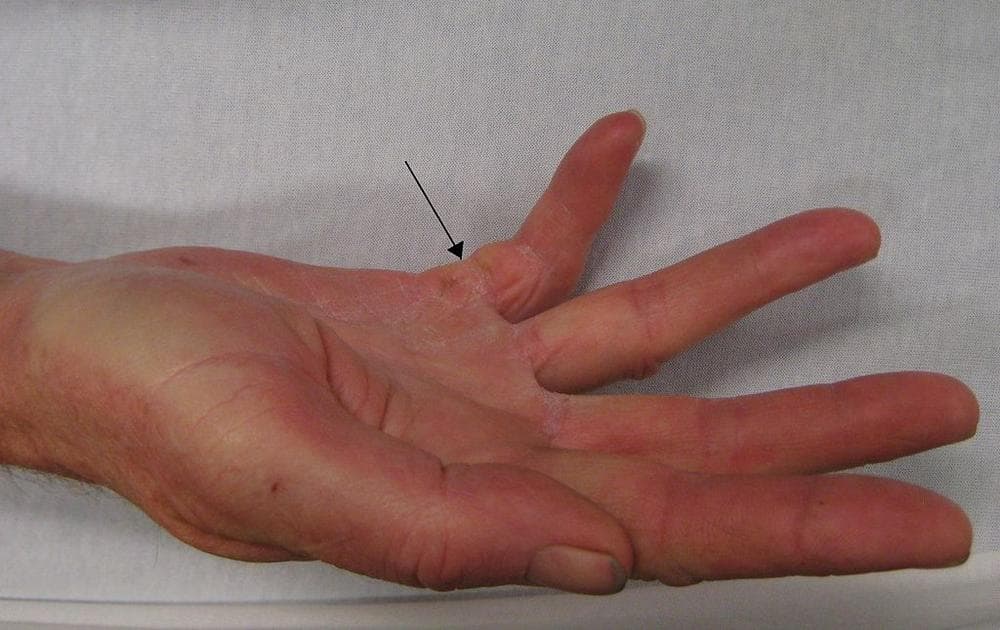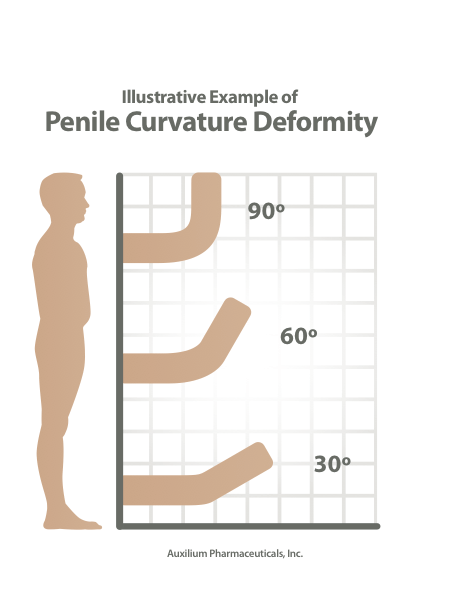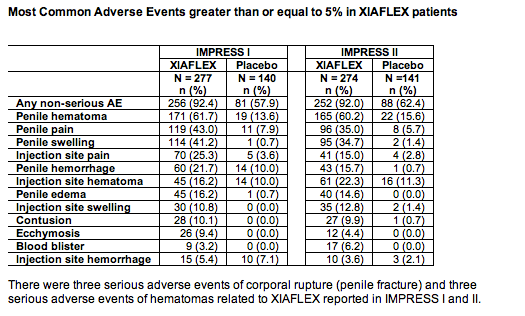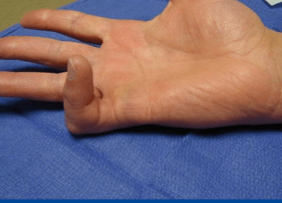Advertisement
Possible Help For Men With Peyronie's, Crooked Penis Disease

I first heard of Peyronie's Disease way back in college, though I didn't then know its name. A dorm neighbor came back from a big-city sexual adventure with an older man, and when we pressed her for juicy details, she crooked her index finger into a hook and shared the perplexing news that this was the geometry of his arousal.
Years later came Bill Clinton's sexual scandals, and rumors that his paramours could describe a telltale bend in the president's erect anatomy. Not long afterward, a new almost-boyfriend bravely sat me down for a well-rehearsed talk: "I have Peyronie's Disease," he said, clearly mortified but toughing it through. "My penis was injured during sex and now it just doesn't straighten or perform the way it used to. It's gotten shorter, and sometimes it hurts."
[module align="right" width="half" type="pull-quote"]'It’s disabling and deforming in the worst possible place for a guy.'[/module]
If you've never heard of Peyronie's Disease — which can range from mild curvature to bends so sharp they make intercourse impossible -- you're in the great majority. Not because the disease is uncommon; it's estimated to affect between 3 and 9 percent of adult men, peaking in their fifties. Rather, Peyronie's is likely so little known because it is so deeply embarrassing that men just don't tend to talk about it.
"It’s disabling and deforming in the worst possible place for a guy," said Dr. Abraham Morgentaler, founder of Men's Health Boston and an associate clinical professor at Harvard. "A lot of these guys are distressed, distraught, and don't know what to do. And the treatments we've had up to today have not been fantastic."
This week, however, brought potentially promising news for men with Peyronie's disease: Two clinical trials for a drug called Xiaflex found that it significantly reduced penile curvature, by a mean of 31 to 38 percent, and tended to lighten their distress.
If you, like me, have trouble computing erection angles in your mind's eye, look at the chart below from Auxilium Pharmaceuticals, the company that makes Xiaflex. Very roughly, men started the year-long trial just under the 60-degree curvature in the middle, and ended up close to the 30-degree curvature at the bottom.

Xiaflex, which is given by injection, is already FDA-approved for a hand problem called Dupuytren's contracture, and Auxilium says it aims to apply for Peyronie's Disease approval by the end of this year. If approved, Xiaflex could start going out to urologists in the second half of next year.
"If it’s approved, it would be the first effective FDA-approved treatment for Peyronie's Disease," said Dr. Morgentaler, whose practice participated in the clinical trials for the drug.
Overall, among the more than 500 patients who have received Xiaflex in two trials, the drug did cause some side effects, mainly bruising, pain, swelling and hemorrhage at the site of the injection. Six cases were considered serious. (Here is the full company press release.)

Among Dr. Morgentaler's patients, he said, "We clearly had a couple of individuals in our series who had a very substantial improvement in their curvature and were thrilled with it — and others who didn’t, but we don’t know whether they got the drug or the placebo. What we’re seeing in the overall results of these trials is that not everybody is going to respond to this, and it wouldn't be reasonable to think they would, but I think that these are moderately good results."
How it works
The true cause of Peyronie's disease remains a mystery, but here's the prevailing theory: A man's penis sustains a subtle injury, a "microtrauma," perhaps during sex. Possibly influenced by genetics, an abnormal wound-healing response starts laying down excessive amounts of collagen, a fibrous protein, as a plaque on the "tunica albuginea." That's the balloon-like wrapper along the shaft of the penis that surrounds the spongy tissue that absorbs blood and allows a man to get an erection. The plaque may cause the penis to deform in a bend or arc from 30 to 90 degrees when it is erect.
I got that wonderfully clear explanation from Will Sargent, Auxilium's vice president of corporate communications, and he extends it to illustrate how Xiaflex works. Picture, he said, the kind of long balloon that a clown blows up. Now imagine that you put inflexible tape on one side of the balloon before you blow it up. When inflated, the balloon will deviate in one direction. That's Peyronie's Disease.

With Xiaflex, he said, you inject the drug — which is an enzyme that breaks down collagen — just under the skin into the plaque at the maximal point of curvature. The drug acts like an "enzymatic scalpel," he said, and "the goal is to just eat away enough of that tape so that the tape breaks in two pieces and the balloon becomes straighter."
The need for treatments
Auxilium, a biopharmaceutical company that also markets a testosterone gel called Testim, focused on Peyronie's Disease to fill a vacuum, Mr. Sargent said.
"Before we went public in 2004," he said, "We went out to urologists and said, 'What disease has just an unmet need that you wish you had something for? And they all said Peyronie's." (The disease is named for the 18th-century surgeon who described it, Francois Gigot de la Peyronie.)

Peyronie's Disease sometimes resolves by itself; in milder cases, doctors might prescribe Vitamin E or other pills, but they don't tend to do much, Dr. Morgentaler said.
The next step up in treatment is injection of a drug called Verapamil, he said, which sometimes helps, though it is not FDA-approved for Peyronie's. And for severe and otherwise intractable cases, surgery can "tighten up the side opposite the curve," to straighten it out.
But surgery, with its risks of complications and penile shortening, is a daunting prospect. Auxilium estimates that though 65,000 to 120,000 American men get a formal Peyronie's Disease diagnosis every year, only about 1,500 to 2,000 resort to surgery.
If it hurts, stop
As a woman, I know I can't fully project what it's like to be a man with Peyronie's Disease, but I can imagine few things harder on a man's physical self-esteem than a disease that may make his penis shorter, deformed, painful and possibly unable to engage in intercourse altogether.
A Journal of Sexual Medicine study found overwhelming levels of distress in men with Peyronie's Disease: 81 percent reported emotional problems and 54% reported relationship problems.
I asked Dr. Morgentaler: With such potential for emotional and physical pain, and treatment still less than ideal, is there some way to prevent Peyronie's Disease?
Because trauma is thought to trigger it, he said, he advises men not to let their penises get bent during sex, particularly when the woman is on top and more in control of the motion.
"A lot of guys want to experiment with stuff they’ve seen — in the Kama Sutra, on the Internet — and amazingly, they've done CT scans of couples having sex, and sometimes the penis is in a bent position. So guys just have to be aware that if something is hurting them during sex, it’s probably a good idea to change out what you’re doing."
This program aired on June 8, 2012. The audio for this program is not available.
